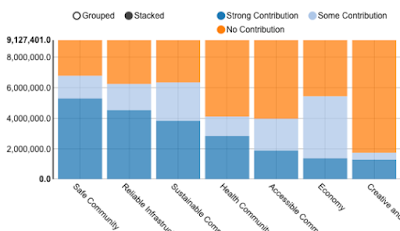"Priority based budgeting will better allow the city to support its long-term strategic goals based on community values."
This article originally written by Becky Zimmer from the Humboldt Journal.
The public had their chance to ask questions on April 5th at the public budget meeting at the Uniplex.
City Manager, Roy Hardy, made the presentation to a small crowd on what the 2016 budget is going to look like in terms of tax increases and social programs.
Unlike the budget draft that had a $3.6 million deficit, Hardy presented a $260,000 deficit to the public since now some more finite numbers have been decided, including some revenue streams that were not included in the draft budget.
"We're getting down to the final budget decisions that need to be made. It needs to be put in council hands."
When it comes to the amount of feedback the city has received from Humboldt residents, the waste management program has received the most feedback through social media.
"Council is going to have to look at that one very seriously," says Hardy. "There are a number of viewpoints that say yes, it is good, shows that we're becoming a city.... and on the other hand there are others that say how is this going to benefit me?"
Council has to look at the community as a whole when it comes to these split decisions.
Hardy says the waste management program will make Humboldt greener and cleaner so that has to play a big role in the decision.
The needs and wants are always going to be greater than the amount of money the city has to work with.
Priority Based Budgeting, which was brought in fully this past budget season, allows for the rating of
programs on a one to four scale. Looking at the rated programs, there is $12 million dollars that is doing what it needs to do in the one and two rated categories, says Hardy. Three and four ranked programs, which make up $2.3 million for analysis, does not mean the program needs to be scrapped. Hardy says it just means that the programs need to be evaluated more fully.
"In some cases, there are going to be some programs that score low but we still have to have them at the end of the day."
Some of these numbers can be deceiving since money can be spent on one program that fits many city goals.
When it comes to the different goals receiving money, Humboldt spends more money on being a safe, reliable infrastructure, and sustainable community.
That paints a picture that Hardy says the city did not have before.
The city can now see the correlation between dollars spent and the values that they want to focus on, says Hardy. Priority spending then takes it a step further and evaluates if the city is getting the, "best bang for the buck."
Creating new partnerships is something the city needs to look at going forward, says Hardy. With major projects coming up, including the Multiplex, Centennial Park, and more infrastructure work that needs to be done, regional partnerships and discussion needs to take place.
"Some of the services we are looking to provide are ones you won't find in a smaller municipality. We have to make the effort in saying what would be the benefit to the residents of your municipality if Humboldt had this type of facility or developed these programs."
Community grants is something that Hardy thinks the city should reevaluate when it comes to budgeting for programs, with exception to the Community and Leisure Services Department.
To get these programs running without city based grants, Humboldt would need help from other partnerships.
An example of the types of partnerships Hardy is mentioning are things like the LED sign west of the city. It is on city land but there were no tax dollars that went into the sign itself. The city gets the benefits of it without burdening taxpayers.
"That's a kind of partnership that takes on a different look, so those are the things that we're exploring with others."
The CPBB congratulates the City of Humboldt on their innovative work implementing priority based budgeting. And their utilization of PBB to accelerate actionable decision-making, especially surrounding partnership opportunities.
To find out more about how City of Humboldt utilizes and applies priority based budgeting data, check out the following links:
City of Humboldt 2016 Public Budget Presentation
2016 City Budget Information
"Our Humboldt" Strategic Plan Incorporates Priority Based Budgeting
City of Humboldt Budget Page of Website
The Center for Priority Based Budgeting
“A Prioritized World”
2016 Annual (Un)Conference

Denver, Colorado | August 2 - 4, 2016
Sheraton Denver Downtown Hotel

















